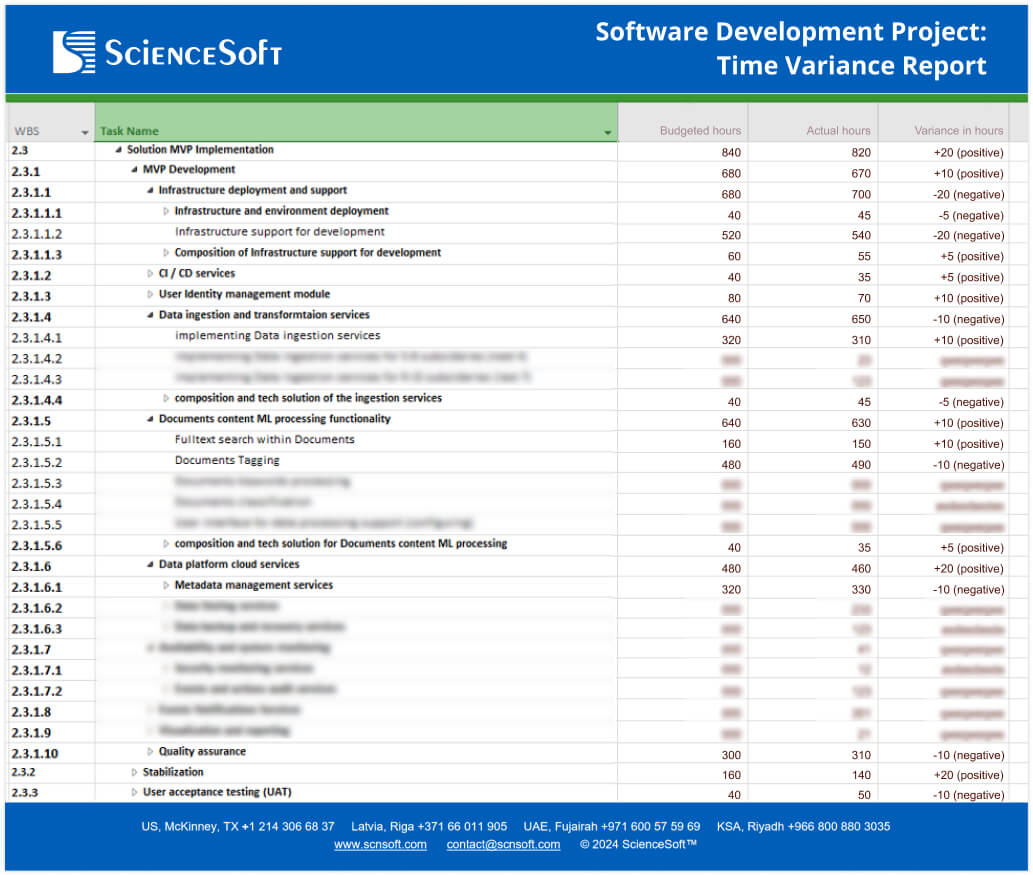Project Budget Management: How to Prevent Unplanned Expenses
Budget overrun inevitably leads to tension between a client and a software development vendor and can cause premature project termination. ScienceSoft's project management office has summarized key rules of budget management helping our teams consistently meet budget goals:
- Realistic cost estimation backed up by the risk mitigation plan.
- Change management to avoid scope creep and control changes in requirements after the contract has been signed.
- Monitoring the budget spending by preparing variance reports and comparing planned vs. actual costs.
Why Budget-Related Problems Are So Frequent and How ScienceSoft Avoids Them
We know about widespread budget management practices firsthand. We often inherit projects from other vendors and talk to clients about the problems that forced them to change their development partner. As the failure to respect budget agreements is a frequently voiced reason for disappointment, we looked deeper into the problem and summarized what we do differently to prevent it.
|
|
What goes wrong |
How we make it right |
|---|---|---|
|
Unsuitable pricing model
|
A pricing model that doesn't take into account the scope of the project undermines all further budget management attempts. For example, a vendor who chose a fixed-price model for a project with obviously fluctuating requirements will be unable to keep the budget within the agreed frames. |
We don't have a preferred pricing model and analyze a client's situation to advise on the beneficial model. In about 90% of cases, clients have evolving needs and requirements, so the time & material pricing model is most frequently used in our projects. However, a fixed-price model is also viable for short-term engagements or projects with a defined scope. |
|
Incorrect cost estimation
|
Vendors may underestimate projects to win contracts. The budget will surely run out before the software is ready for deployment, but some recklessly go into this risk. |
At the discovery stage, we analyze all cost factors, such as software requirements, a development approach, team composition, operational expenses, and others. This gives us enough context for accurate project scoping and estimation. |
|
Disregard of risks
|
Vendors may fear admitting risks openly to avoid looking incompetent and unable to lead a project without problems (many still think that risks = problems). The truth is, there are always risks, and without a mitigation plan, they may have a devastating effect on the project cost. |
We acknowledge risks and plan mitigation actions at the start of the project to improve project predictability and prevent unbudgeted expenses. |
|
Miscommunication between developers and project managers
|
A common practice of project cost estimation looks as follows: developers assess the time needed for a task, and a project manager adds a time buffer and calculates the cost based on the rates. The process goes wrong when developers overestimate the time to be on the safe side. A project manager gets skewed figures, ultimately giving an inflated cost estimate. |
We establish clear roles and responsibilities: developers assess the work as-is, and project managers analyze whether the initial assessment is realistic and calculate the risks. |
|
Uncontrolled budget spending
|
Suppose a vendor doesn’t control the adherence to the initial budget during the project. In that case, they notice they went over the budget only when the gap between the planned budget and the actual spending is too wide to bridge painlessly. |
During the project, we monitor the budget variance to spot discrepancies between the budget and actual costs early, uncover the reasons, and take corrective measures. |
A Full Cycle of Project Budgeting
Below, we share a sample budgeting process at different stages of the project lifecycle.
1.
Pre-sale stage
- Eliciting high-level project requirements.
- Using early estimation techniques (e.g., T-shirt sizing or similar estimation methods) to facilitate a client's decision on starting the project.
2.
Discovery stage
- Designing software requirements.
- Estimating the currently visible scope of the project using the best-suited approach:
- A top-down approach, where we estimate the entire project budget and then split it between the major activities. The method is best suited for standard and fixed-scope projects.
- A bottom-up approach, where we estimate individual functional units and then piece together a total budget. Best-suited for software developed in an Agile manner.
- Identifying project risks that can impact the cost and assessing their probability. Numerous factors can cause one type of risk. For example, scope creep may happen due to changes in the target business process or the involvement of many stakeholders with different views. The more factors apply, the higher the risk probability.
- Planning risk mitigation activities.
- Assessing the budget needed for risk prevention or mitigation of consequences if the risk has been realized.
3.
Sprint planning
- Deciding what piece of functionality will be delivered in an upcoming sprint and reviewing the requirements.
- Selecting team members who will participate in full-cycle sprint realization (planning-development-testing-deployment).
- Estimating the sprint budget.
How We Control Budget Execution in the Course of the Project
- We have a structured and regulated process for change management. It functions throughout the project and allows us to process changes in requirements without slipping into scope and budget creep.
- We quickly address emerging risks. Here are some examples of techniques to we use to prevent budget overruns:
- Backlog grooming. We review and prioritize the planned features based on their immediate and long-term value and efforts required to create them. Often, stakeholders’ needs change, and must-have features can become desirable or even unneeded. Regularly monitoring and managing priorities helps reallocate resources and deliver the most valuable functionality within the available budget.
- Freezing change requests. We agree with a client to temporarily stop accepting change requests leading to the extension of the scope for the sake of delivering on initial requirements without exchausting the budget prematurely.
- Resource optimization and substitution. For non-critical activities, we may consider replacing highly specialized, higher-cost specialists with less expensive resources who possess the necessary skills for those specific tasks.
- Component reusability. We reuse functional components and the coding logic whenever possible.
- We use variance reports to compare planned vs. actual time and correlate it with the costs. A positive variance in the report means that the actual spending was lower than planned expenses. A negative variance is a point for our immediate attention as it means that we overspent the budget allocated for a particular task. All projects inevitably have positive and negative budget variances and it's the responsibility of a project manager to balance them.
See a sample of a variance report

Hide


